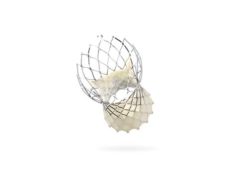
The feasibility, safety, and efficiency of transcatheter aortic valve implantation (TAVI) using a self-expanding platform in bicuspid aortic valves has been confirmed by the BIVOLUT X registry, Didier Tchétché (Clinique Pasteur, Toulouse, France) told PCR e-Course 2020 (25–27 June). Describing BIVOLUT X as “one of the first prospective registries in bicuspid aortic valves, with a robust academic setting”, Tchétché said it had also observed that an annular based or combined sizing strategy is efficient for TAVI bicuspid aortic valves.
The registry enrolled 151 patients with severe symptomatic bicuspid aortic valve disease at 14 centres across Europe and Canada. Patients underwent TAVI with the self-expanding Evolut Pro or Evolut R 34 platforms (Medtronic). Primary endpoints were a haemodynamic endpoint of valve performance and a computed tomography (CT) endpoint of the ellipticity index, as assessed by post-TAVI CT scans, both at 30 days. The secondary endpoint was safety at 30 days. Endpoints will also be assessed at one year.
Mean age of the study population was 78±7.5 years, and 94% were male. The mean Society of Thoracic Surgeons (STS) score was 2.5 (95% confidence interval [CI] 1.7–3.9), and 42.4% (n=64) were in New York Heart Association (NYHA) class III–IV. At baseline, 8.1% (n=12) had had a previous pacemaker or implantable cardioverter defibrillator (ICD), and 6.7% (n=10) had right bundle branch block.
The predominant bicuspid aortic valve type was type 1 L-R, which was present in 73% of patients, with 9.9% type 0, and 3% with a type 2 bicuspid aortic valve. Calcified raphe was observed in 34.4% (n=52) of patients, the ellipticity index at baseline at the aortic annulus level was 1.3±0.1, and “as expected,” said Tchétché, “the calcium burden was really high in the population”.
He also noted: “The sizing strategy had to be pre-declared by the centres before treating the patients. We observed that 50% of the centres were sizing only based on the annulus, while the other half of the centres were sizing based on a combination of the annular measurements and the supra-annular measurements, whether it be the commissural-to-commissural distance or supra-annular tracing.”
There were no major differences in oversizing ratios observed between type 0 and type 1 bicuspid valves.
On procedural details, Tchétché said: “Reassuringly, 97% of the patients only required one device, and this is probably related to the repositionability of the platform, as repositioning was utilised in 30% of the cases. Predilatation was quite systematic—87% of the cases—and postdilatation was quite frequently applied, in 55% of the patients.”
At 30 days, all-cause mortality had occurred in 3.3% of the cohort, but only 1.9% were cardiovascular deaths. At 3.3%, the rate of disabling stroke was “more reassuring than in the interim analysis”, said Tchétché, and the rate of major vascular complications was 4.6%; 19.6% of the cohort required a pacemaker. There were no differences between sizing methodologies.
“These data, overall, confirm the safety of TAVI bicuspid aortic valves, as has been observed in most of the retrospective registries. The echo outcomes at 30 days confirm the efficiency of TAVI in bicuspid valves with the self-expanding Evolut platform. The mean effective orifice area [EOA] at 30 days was 2.1cm2, and the mean gradient was only 7.3mmHg. Paravalvular regurgitation was also one of the very positive findings: very few patients had moderate regurgitation—2%—and no patient had moderate-severe or severe regurgitation. Patient–prosthesis mismatch was observed in 10.5% of the cohort, but it was severe in only 1.3% of the patients. It was highly efficient, with excellent haemodynamics in bicuspid aortic valves.”
“On the primary and secondary endpoints, valve performance—a composite of the mean aortic valve gradient <20mmHg, or peak velocity <3m/s, and no moderate or severe aortic regurgitation—was 98% at 30 days; VARC 2 device success, “expressing the safety profile of the device in that indication”, was observed in 96% of the patients, with no difference between sizing strategies or type 0/type 1 bicuspid aortic valves (annular 93.6% vs. combined 98.6%, p=ns). On the CT outcome of the ellipticity index, said Tchétché, “we observed reshaping of the annulus ellipticity, with an ellipticity of 1.22 (95% confidence interval 1.14–1.35), as compared to the 1.3 that was at baseline”.
He concluded: “The Evolut Pro and XL platforms demonstrate large effective orifice areas, low gradients and minimal aortic regurgitation in type 0 and type 1 bicuspid aortic valves, without an excess of ellipticity at the annular level. We also observed a re-shaping of the annulus postprocedure. A systematic predilatation accompanied by tailored postdilatation may help in preventing greater ellipticity. The repositioning capability of the Evolut Pro/XL platform seems to be of particular utility for TAVI in bicuspid aortic valves.”










